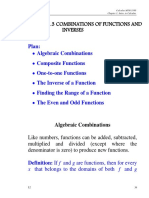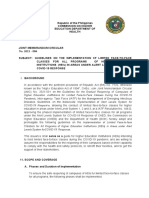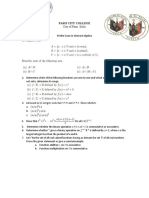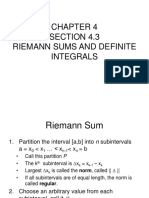Operations With Functions
Uploaded by
Miguel PAlmaresOperations With Functions
Uploaded by
Miguel PAlmaresOperations with Functions.
If f and g are two functions, a new function f(g), called the composition of g with f, is defined by
(f(g))(x) = f(g(x)).
x+1
For example, if f ( x )=x 3−1 and g ( x )= , then
x −1
The composition of two functions is the function obtained by applying one after the other. If f and g are
regarded as computing machines, then f (g) is the composite machine constructed by feeding the output
of g into the input of f.
Note: f (g) ≠ g (f).
Find (g (f)) (x).
Arithmetic Operation of Functions
If f and g are two real-valued functions, we can perform the usual arithmetic operations of
addition, subtraction, multiplication, and division.
Find 1. f(x) + g(x) 2. f(x) − g(x) 3. f(x) g(x) 4. f(x)/g(x)
The product function fg should not be confused with the composite function f (g).
Example:
Let f(x) = x5 and g(x) = x3.
The product af of an arbitrary real number a and real-valued function f. The product function is defined
by
(af)(x) = af(x).
Example 8. Let functions f and g be defined by f (x)= x−2and f (x)=g (x)=x 2−5 x +6. Draw the
graphs of f, g, 2f, and f + g.
You might also like
- 1.2 Operations On Functions and Types of FunctionsNo ratings yet1.2 Operations On Functions and Types of Functions17 pages
- (F + G) (X) F (X) (F G) (X) F (X) G (X) (F - G) (X) F (X) G (X) (X)No ratings yet(F + G) (X) F (X) (F G) (X) F (X) G (X) (F - G) (X) F (X) G (X) (X)1 page
- 1.5 Function Composition: (From Wikipedia, Author Tlep, Available Under The Creative Commons License.)No ratings yet1.5 Function Composition: (From Wikipedia, Author Tlep, Available Under The Creative Commons License.)5 pages
- Combintion of Functions (Operation and Composition)No ratings yetCombintion of Functions (Operation and Composition)21 pages
- StewartCalcET8_01_03 New Functions from Old FunctionsNo ratings yetStewartCalcET8_01_03 New Functions from Old Functions21 pages
- Algebra of Functions Composition SymmetryNo ratings yetAlgebra of Functions Composition Symmetry9 pages
- 1.8: Combining Functions Composite Functions: Learning GoalsNo ratings yet1.8: Combining Functions Composite Functions: Learning Goals6 pages
- LESSON 1 - FUNCTIONS AND EVALUATION OF FUNCTIONSNo ratings yetLESSON 1 - FUNCTIONS AND EVALUATION OF FUNCTIONS40 pages
- c03CompositeFunctionsTransformationsAndInverses Holiday HomeworkNo ratings yetc03CompositeFunctionsTransformationsAndInverses Holiday Homework56 pages
- C01 Calculus of One Variable - T1 - 1112No ratings yetC01 Calculus of One Variable - T1 - 111251 pages
- Differential Calculus: Engr. Joeydann M. TelinNo ratings yetDifferential Calculus: Engr. Joeydann M. Telin41 pages
- General Mathematics MODULE 3 Part 1 OPERATIONS OF FUNCTIONSNo ratings yetGeneral Mathematics MODULE 3 Part 1 OPERATIONS OF FUNCTIONS16 pages
- GEN MATH 11 - Lecture Note - Operations On FunctionsNo ratings yetGEN MATH 11 - Lecture Note - Operations On Functions2 pages
- Composite Functions: Maryam Mozayan Chinica Madurkar Modita Jain Kanishk Jena Parthvi SachanNo ratings yetComposite Functions: Maryam Mozayan Chinica Madurkar Modita Jain Kanishk Jena Parthvi Sachan18 pages
- Composition of Functions: (G F) (X) G (F (X) )No ratings yetComposition of Functions: (G F) (X) G (F (X) )11 pages
- 1.3 New Functions From Old Functions 1. Sketch The Graphs of y X + 2, y (X 1), and y (X 1) + 2No ratings yet1.3 New Functions From Old Functions 1. Sketch The Graphs of y X + 2, y (X 1), and y (X 1) + 24 pages
- 8 5 Algebra and Composition of FunctionsNo ratings yet8 5 Algebra and Composition of Functions20 pages
- Operations of Functions: General MathematicsNo ratings yetOperations of Functions: General Mathematics12 pages
- Exponential Functions and Their Graphs: Digital LessonNo ratings yetExponential Functions and Their Graphs: Digital Lesson10 pages
- QA - Algebraic Function: Proprietary and Confidential ABS ClassesNo ratings yetQA - Algebraic Function: Proprietary and Confidential ABS Classes1 page
- Mathematical-Language-and-Symbols-The-Language-of-Relations-and-FunctionsNo ratings yetMathematical-Language-and-Symbols-The-Language-of-Relations-and-Functions20 pages
- Addressing the Digital Divide in AustraliaNo ratings yetAddressing the Digital Divide in Australia6 pages
- National Service Training Program 1 Vivian G. PadernalNo ratings yetNational Service Training Program 1 Vivian G. Padernal3 pages
- GE 102 Purposive Communication: School of Teacher EducationNo ratings yetGE 102 Purposive Communication: School of Teacher Education5 pages
- Passi City College Passi City, Iloilo School of Teacher Education Module in National Service Training Program I (CWTS I)100% (1)Passi City College Passi City, Iloilo School of Teacher Education Module in National Service Training Program I (CWTS I)4 pages
- Module 1 Action Research in MathematicsNo ratings yetModule 1 Action Research in Mathematics16 pages
- The Last The Last: "Love Doesn't Mean Happiness, It Also Need Your Patience and SacrificesNo ratings yetThe Last The Last: "Love Doesn't Mean Happiness, It Also Need Your Patience and Sacrifices4 pages
- Section 4.3 Riemann Sums and Definite IntegralsNo ratings yetSection 4.3 Riemann Sums and Definite Integrals38 pages











































































